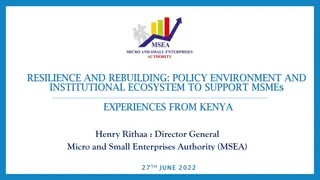Realizing Equitable and Inclusive Education in Kenya
Inclusive education in Kenya is still in early stages, facing barriers like poverty, teenage pregnancies, and healthcare access. The policy framework in Kenya, including the 2010 Constitution and Education Act, supports the principle of inclusive education by prohibiting discrimination and ensuring every child's right to education.
Download Presentation

Please find below an Image/Link to download the presentation.
The content on the website is provided AS IS for your information and personal use only. It may not be sold, licensed, or shared on other websites without obtaining consent from the author.If you encounter any issues during the download, it is possible that the publisher has removed the file from their server.
You are allowed to download the files provided on this website for personal or commercial use, subject to the condition that they are used lawfully. All files are the property of their respective owners.
The content on the website is provided AS IS for your information and personal use only. It may not be sold, licensed, or shared on other websites without obtaining consent from the author.
E N D
Presentation Transcript
INCLUSIVE AND EQUITABLE INCLUSIVE AND EQUITABLE EDUCATION IN EDUCATION IN KENYA KENYA MARGARET MARGARET WAWIRA WAWIRA- - EAST AFRICAN EAST AFRICAN CENTRE CENTRE FOR HUMAN RIGHTS FOR HUMAN RIGHTS MARGARET@EACHRIGHTS.OR.KE MARGARET@EACHRIGHTS.OR.KE
Introduction Introduction Policy Climate & Status of Policy Climate & Status of Implementation Implementation PRESENTATION PRESENTATION OUTLINE OUTLINE Realising Realising Equitable and Inclusive Equitable and Inclusive Education in Kenya Education in Kenya Recommendations & Conclusion Recommendations & Conclusion
Inclusive education involves transformation of education systems to accommodate all learners. Its successful implementation is founded on policy Realisation of Inclusive education is in its nascent Stage in Kenya, and many barriers currently exist in the development of an inclusive education system. Such barriers include: poverty Location Location; Teenage Teenage Pregnancies Pregnancies; child natural natural disasters disasters, HIV/AIDS HIV/AIDS, gender healthcare healthcare, access access to to food education education and availability availability of of clean water water. . INTRODUCTION poverty, Geographical Geographical child labor gender, access food, Privatisation Privatisation of of clean drinking labor, access to to drinking
POLICY CLIMATE & STATUS OF IMPLEMENTATION
HUMAN RIGHTS HUMAN RIGHTS TREATIES AND TREATIES AND CONVENTIONS CONVENTIONS
Policy Policy Key Components Key Components Policies & laws on Equity and Inclusion The Kenyan The Kenyan constitution constitution 2010 2010 Prohibits discrimination in Article 27, Section 4, which states: The State shall not discriminate directly or indirectly against any person on any ground, including race, sex, pregnancy, marital status, health status, ethnic or social origin, colour, age, disability, [emphasis added] religion, conscience, belief, culture, dress, language or birth. (p. 24) Article 43(1) (f) acknowledges that every person has the right to education. Every child s right to free and compulsory basic education is entrenched in article 53 (1), Basic Basic Education Act Education Act (2013) (2013) Streamlines the provision of education in institutions of basic education, in line with the 2010 Constitution. no pupil shall be refused admission to, or excluded from, the school on any grounds of sex, race or colour or on any other than reasonable 21 grounds (Admission and removal of pupils). This in essence affirms the principle of inclusive education in Kenyan learning institutions.
Policy Policy Key Components Key Components Policies & laws on Equity and Inclusion Basic Basic Education Education Regulations Regulations (2015 (2015 Gazzetted Gazzetted) ) 83 (c) provides that the school environment is such as to nurture positive health and is conducive to learning and social development without compromising diversity or disability; 50 (d) A person, body, organ or institution responsible for the management of a pre-primary, primary or secondary school shall have provisions for disability- friendly facilities and environment. The Persons The Persons with with Disabilities Disabilities Act (2003) Act (2003) Legal framework which outlaws all forms of discriminative treatment of persons with special needs and disabilities. This includes, among others, access to education and training. Provides for adaptation of infrastructural, socio- economic and environmental facilities to ensure a conducive environment for persons with special needs and disabilities.
Policy Policy Key Components Key Components Policies & laws on Equity and Inclusion The Children s The Children s Act (2001) Act (2001) Harmonizes all existing laws and policies on children into one document and aims at improving the well-being of ALL children irrespective of whether they are disabled or not. Not aligned to the 2010 constitution. Has been under review since 2008. It addresses some of the critical issues which determine delivery of quality and relevant education for children with special needs. National National Special Needs Special Needs Education Education policy policy framework framework 2009 2009 Reinstates the government s commitment to the provision of equal access to quality and relevant education and training opportunities to ALL Kenyans. Referenced for definition of key terms
Policy Policy Key Components Key Components Policies & laws on Equity and Inclusion The Sessional The Sessional Paper No. 1 Paper No. 1 of 2005 of 2005 States in part the overall government policy direction on learners with special needs and disabilities. It sets out clear policy guidelines for all education sub- sectors, including SNE and further underscores the government s commitment to ensuring that learners with special needs and disabilities have equal access to quality and relevant education. The Gender The Gender policy in policy in Education Education 2015 2015 Singles out education for learners with special needs and disabilities as an area of specific focus. This policy emphasizes the need for an enabling environment to increase participation, retention and completion for learners with special needs and disabilities. i.e flexing curriculum, trained personnel, equipment and facilities
Policy Policy Key Components Key Components Policies & laws on Equity and Inclusion National National Education sector Education sector plans (current plans (current running until running until 2022) 2022) Developed to help the Government achieve the targets as outlined in the Sessional Papers Establishment of key institutions e.g KISE Free Primary Free Primary Education (2003) Education (2003) Access to free primary education for All children Capitation for students with disabilities
Policy Policy Key Components Key Components Policies & laws on Equity and Inclusion Kenya Policy & Guidelines Kenya Policy & Guidelines on Alternative Provision on Alternative Provision of Basic Education and of Basic Education and Training (2009) Training (2009) Target's children in urban informal settlements and marginalised areas. Provides the necessary guidelines to streamline the development and management of alternative channels that provide education and training to needy Kenyans Basic Education Basic Education Curriculum Framework Curriculum Framework 2019 2019 Captures engagement of learners with special needs under two modalities: those who follow the regular curriculum and those who may not.
Policies & laws on Equity and Inclusion Policy Policy Key Components Key Components Great milestone for learners and trainees with disabilities in the county Sector policy Sector policy for learners for learners and trainees and trainees with with disabilities disabilities 2018 2018 Concentrates on 11 categories of disabilities: hearing impairment; visual impairment; deaf-blindness; physical impairment; intellectual and developmental disabilities; specific learning disabilities (dyslexia, dyscalculia, dysgraphia); cerebral palsy; speech and language difficulties; multiple disabilities; autism and albinism. Covers the entire education and training continuum: Basic to tertiary & recognizes the need for Kenya to move towards inclusive education, instead of segregated education. Inclusive education is the overarching principle, advocating for the right of every learner with disability to be enrolled in regular classroom together with his or her peers without disabilities.
Policies & laws on Equity and Inclusion Policy Policy Key Components Key Components - The Ominde report (Kenya Education Commission, 1964 - The National Education Commission (the Gachathi Report, 1976) - The Presidential Working Committee on Education And Training For This Decade And Beyond, (The Kamunge Report, 1988) - Totally Integrated Quality Education And Training Taskforce (The Koech report, 1999) Presidential Taskforces Presidential Taskforces Reports Reports
Inclusion In the wake of Covid Inclusion In the wake of Covid- -19 19
Implementation Implementation of of inclusive inclusive education education practices practices is is anchored anchored on on enforcement enforcement of of existing existing Policy Policy and and Legislation Legislation related related to to inclusive inclusive education education. . CONCLUSION CONCLUSION Lack Lack of of proper proper mainstreaming mainstreaming of of inclusion inclusion at at the the school school level level. . Qualitative Qualitative data data also also reveals reveals that that teacher/community teacher/community attitude attitude is is far far the the most most impediment impediment to to inclusive inclusive education education implementation implementation coupled coupled with with teacher teacher motivation, motivation, teaching teaching and and learning learning resources resources as as well well as as large large number number of of pupils pupils in in classes classes. .
Proper Proper comprehensive comprehensive dissemination dissemination of of policies policies across across all all levels levels particularly particularly at at the the school school level level Development Development of of a a country/region country/region- -centered centered plan, plan, and and RECOMMENDATIONS RECOMMENDATIONS implementation implementation of of inclusion inclusion policies, policies, Development Development of of an an inclusive inclusive network network that that monitors monitors challenges challenges hindering hindering the the realization realization of of inclusive inclusive education education for for the the children children of of Kenya Kenya. . Need Need for for school school based based in in service service programmes programmes on on inclusive inclusive education education for for teachers teachers in in the the regular regular schools schools Multisectoral Multisectoral approach approach to to address address barriers barriers. . Awareness Awareness creation creation to to harness harness positive positive attitude attitude towards towards inclusive inclusive education education which which recognizes recognizes diversity diversity as as a a fundamental fundamental value value and and ensures ensures that that no no child child is is left left behind behind. .
FOR MORE INFORMATION: FOR MORE INFORMATION: MARGARET@EACHRIGHTS.OR.KE MARGARET@EACHRIGHTS.OR.KE




































